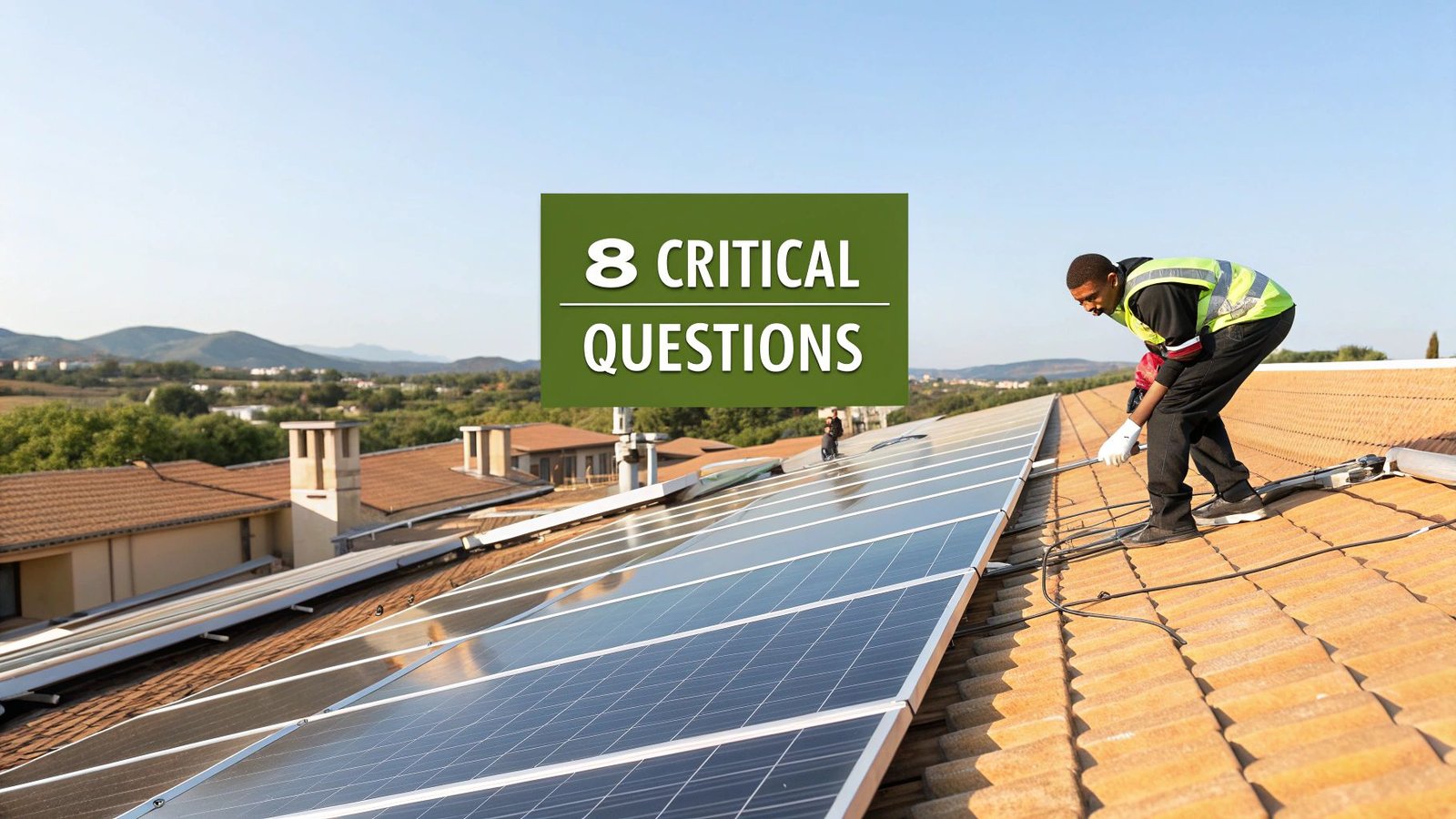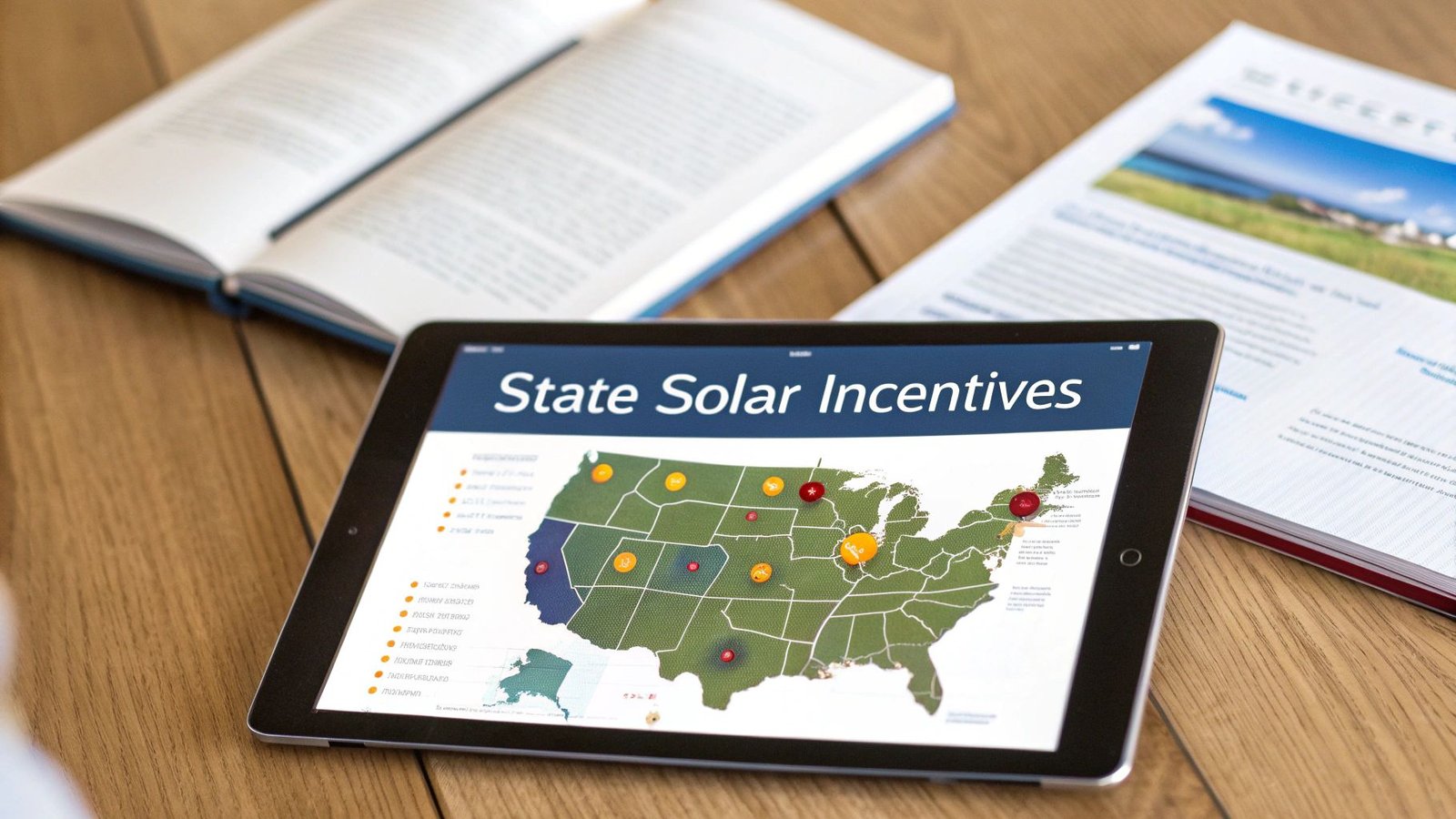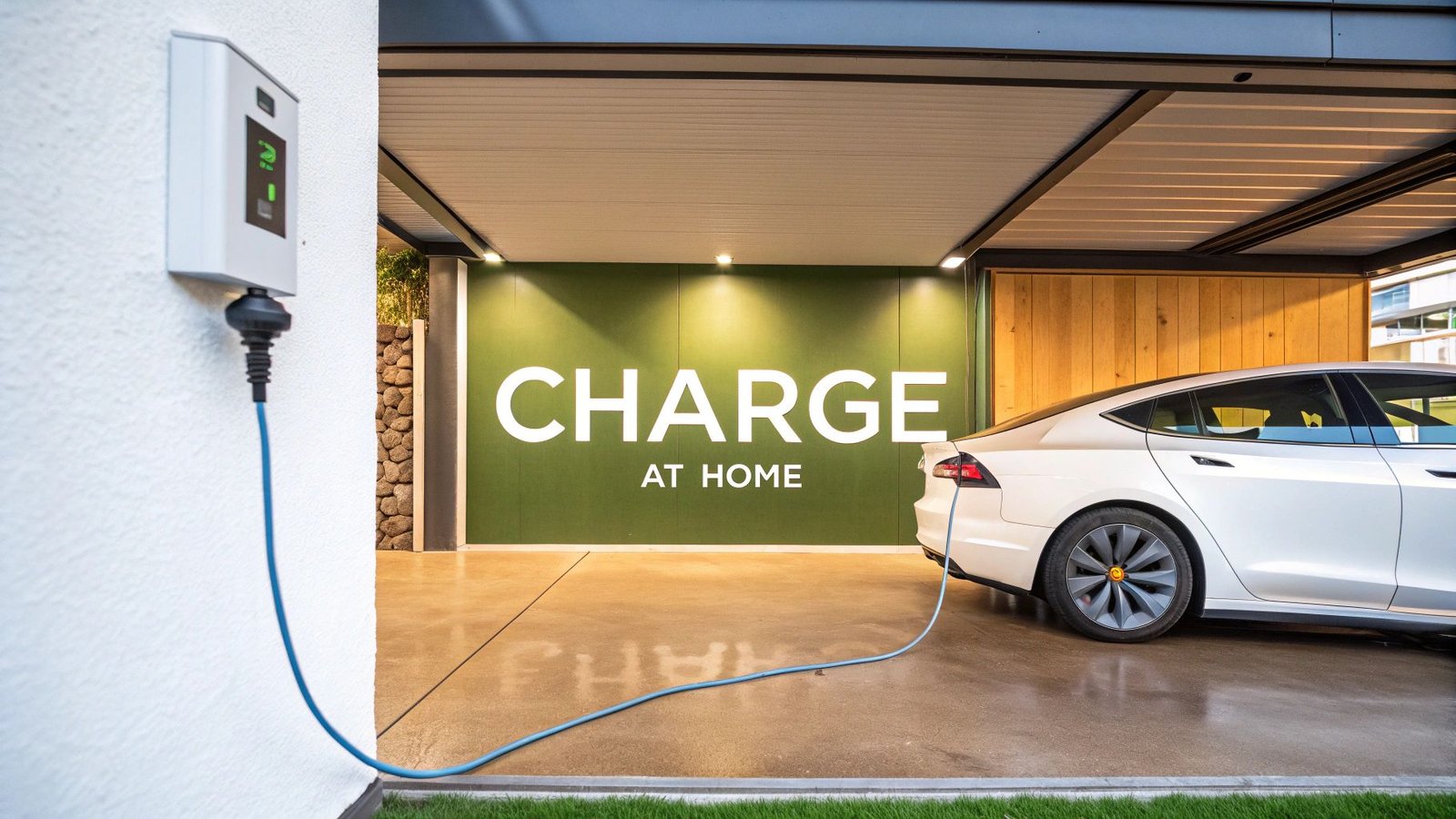Here’s the simple truth: For the Northern Hemisphere, solar panels should face south. If you live in the Southern Hemisphere, they must face north. This one rule is the cornerstone of maximizing your solar energy production.
The Best Way to Position Your Solar Panels
Let's cut right to the chase. The best direction for your solar panels comes down to one simple question: which side of the equator are you on?
Think of a sunflower in a field, always turning its face toward the sun to soak up as much light as possible. Your solar panels work on the same principle. Getting this basic orientation right is the foundation for getting the most out of your investment and is a key part of overall solar panel optimization.
Quick Guide to Ideal Solar Panel Orientation
To make this crystal clear, the table below gives you an at-a-glance guide. You can quickly see the ideal setup for your location before we dig into the "why" and other crucial details like panel tilt and local conditions.
| Your Hemisphere | Ideal Direction | General Tilt Rule |
|---|---|---|
| Northern Hemisphere | South | Angle roughly equal to your latitude |
| Southern Hemisphere | North | Angle roughly equal to your latitude |
This simple directional rule is your starting point for a powerful and efficient system.
Of course, a well-placed solar array is just one piece of the puzzle when you're looking at the bigger picture of building an energy-efficient smart home. But it’s arguably the most important first step.
Getting the direction right ensures your panels receive the maximum amount of direct sunlight throughout the day, which directly translates to more power generated and greater savings on your energy bills.
Why Panel Direction and Tilt Are So Important
So, we know the general direction your panels should face, but let's dig into why this is such a big deal. Getting the orientation just right is all about maximizing the direct sunlight your panels soak up, day in and day out. More sun means more power.
Think of it like trying to catch rain in a bucket. You wouldn't just leave it flat on the ground, would you? Of course not. You’d angle it toward the storm to catch as much water as possible. Solar panels are the same, but they’re catching sunlight. A perfectly positioned panel is like that perfectly angled bucket, capturing every possible photon as the sun makes its daily journey across the sky.
Azimuth and Tilt: The Two Keys to Success
To really get a handle on the best orientation, you need to know two simple but critical terms:
- Azimuth: This is just a fancy word for the compass direction your panels are facing. In the Northern Hemisphere, the sweet spot is 180°, or true south.
- Tilt: This is the vertical angle of the panels in relation to the ground. A panel lying completely flat has a 0° tilt, while one standing straight up is at a 90° tilt.
These two factors work hand-in-hand. Nailing the azimuth ensures your panels are pointed at the sun's path, and getting the tilt right means they’re angled to meet the sun’s rays head-on, no matter how high or low it is in the sky.
The right combination of azimuth and tilt can boost your solar system's annual energy production by up to 25% or even more compared to a poorly placed setup. That translates directly into more savings and faster energy independence.
The difference isn't just a minor tweak; it's a game-changer. You can see it clearly when you look at the daily energy production curves.
As the graph shows, a well-positioned panel gives you that beautiful, high arc of energy production throughout the day. A poorly placed one? You get a much lower, flatter curve. It's a stark visual reminder of just how much proper positioning matters.
How to Find Your Perfect Panel Angle
Alright, let's get down to the nitty-gritty. Figuring out the perfect tilt for your solar panels is actually less complicated than you might think. The best starting point, and often the best year-round angle, is to simply match your home's latitude.
This little trick ensures your panels have the best possible "view" of the sun as it travels across the sky throughout the year.
Finding your latitude is a breeze. Just pop your address into a tool like Google Maps, right-click on your home, and the first number in the coordinates that appear is your latitude. If you live in Denver, Colorado, for instance, your latitude is about 40 degrees. That means the ideal fixed tilt for your panels would be right around 40 degrees.
Optimizing for the Sun's Seasonal Path
But what if you want to squeeze every last drop of power out of your system? You can, by making a few seasonal adjustments.
Think about how the sun behaves. In winter, it hangs low in the sky, while in summer, it's almost directly overhead. By changing your panel's tilt to follow the sun's seasonal position, you can capture significantly more energy.
In fact, studies show that adjusting your tilt seasonally can boost your annual energy production by up to 10–15% compared to leaving it at a fixed angle. You can dive deeper into the numbers and discover more insights about optimal panel tilt on pmc.ncbi.nlm.nih.gov.
A good rule of thumb for these adjustments is:
- Winter: Add 15 degrees to your latitude (e.g., 40° + 15° = 55° tilt).
- Summer: Subtract 15 degrees from your latitude (e.g., 40° – 15° = 25° tilt).
- Spring & Fall: Set the tilt to match your latitude exactly.
This infographic gives a great visual of how to align your panels for maximum sun exposure.
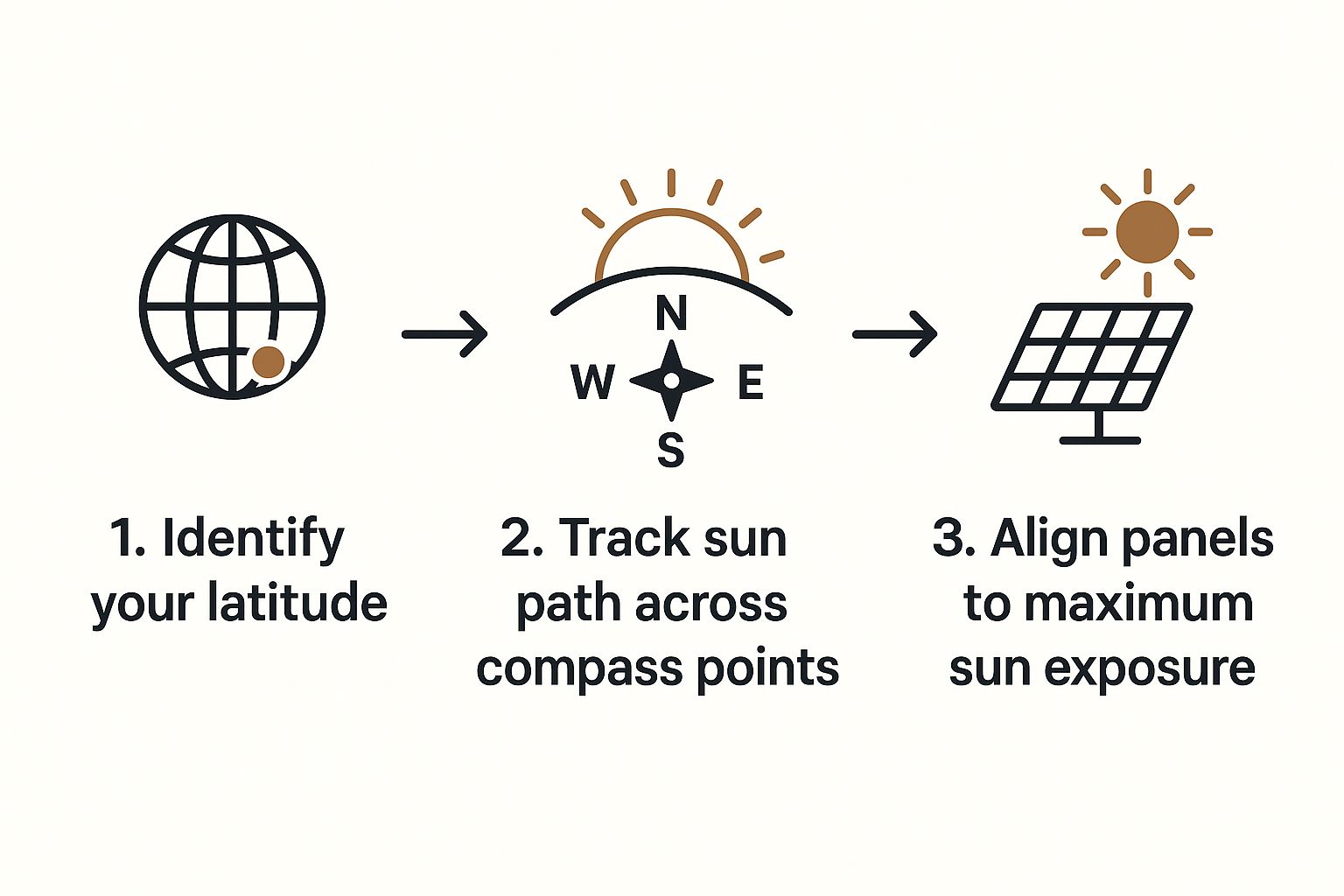
The takeaway here is that finding the best orientation isn't guesswork; it's a logical process that combines your geographic location with the sun's predictable path.
While tweaking your panels a few times a year offers a nice performance bump, the reality is that most homeowners with rooftop systems stick with a single, fixed tilt. These seasonal adjustments are far more practical for ground-mounted systems where the panels are easy to access. Your installer will do the math and determine the absolute best year-round fixed angle for your specific home.
How Your Climate Affects Solar Production
Even with a perfectly south-facing roof, your home's location is a huge piece of the puzzle. The big idea here is something called solar irradiance—basically, it's a measurement of how much strong, usable sunlight actually hits the ground in your specific area.
Think of it like this: your solar array is a top-of-the-line fishing net. Getting the orientation right is like casting that net perfectly. But the local climate is what determines how many fish are actually in the water to be caught in the first place.
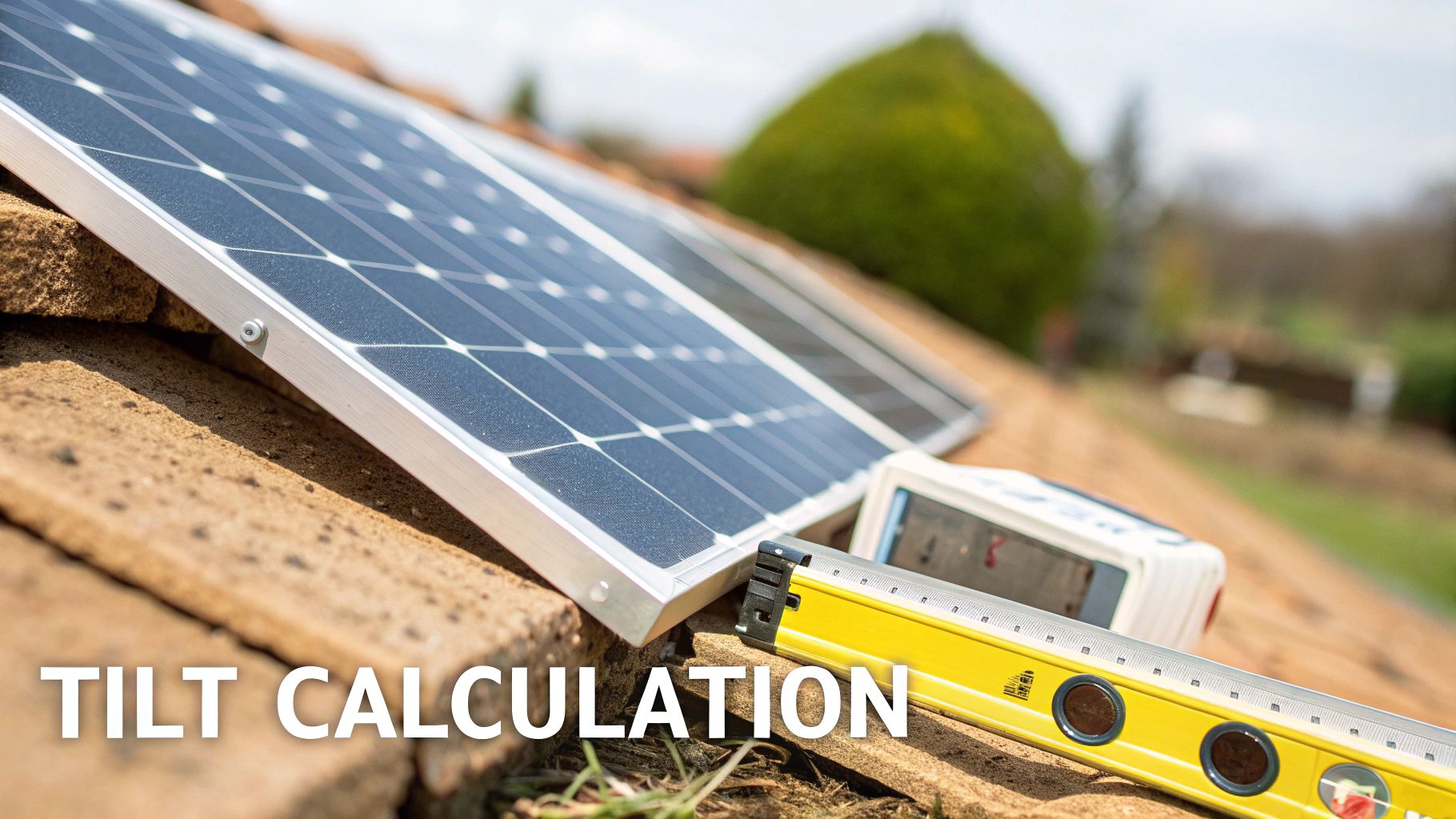
You can see this play out dramatically when you compare different parts of the world. A solar panel soaking up the Arizona sun is in a much richer environment than the exact same panel in the often-overcast United Kingdom. The result is a massive difference in energy output.
Sunshine Hours And Energy Yield
The total amount of sunlight a place gets over a year directly translates to your system's energy production. A high-sunshine spot like the Southwestern USA might get an average of 2,000 kWh/m² every year. A less sunny region, like Southern England, receives about half that. The chart below illustrates the significant impact of location on potential solar generation.
Annual Solar Irradiance Comparison (kWh/m²)
graph TD
A[Southwestern USA] -->|~2,000| B((High Yield))
C[Southern England] -->|~1,000| D((Lower Yield))
style A fill:#f9f,stroke:#333,stroke-width:2px
style C fill:#ccf,stroke:#333,stroke-width:2px
What does that mean for your wallet? A 20% efficient panel in the US Southwest could crank out up to 400 kWh of energy annually. Take that same panel to England, and you’re looking at less than 200 kWh. It’s a perfect example of how location sets the ceiling for your system’s potential.
Your panel's direction helps capture the maximum potential energy, but your local climate determines the actual amount of energy available to harvest.
Of course, weather is more than just sunny versus cloudy. Persistent cloud cover will obviously lower your production, which is a major reason people ask if solar panels work in winter. On the other hand, extreme heat can also make panels slightly less efficient. Knowing these local climate quirks helps you set realistic expectations for what your solar investment can really do.
Navigating Real-World Roof Challenges
In a perfect world, every roof would be a perfect solar canvas: facing due south with a flawless pitch and not a single shadow in sight. But let's be honest, reality is usually a lot messier. What do you do when your roof faces the "wrong" way, or you have to contend with vents, chimneys, and that big oak tree next door?
The good news is, you don’t need a "perfect" roof to get fantastic results from solar. Many homeowners get hung up on the idea that anything less than a south-facing array isn't worth it, but that's one of the biggest myths out there. The real secret is designing a system that works brilliantly with the roof you have.
When Your Roof Doesn't Face South
If your main roof plane points east or west, you’re still in a great position to generate a ton of power. While a true-south orientation is the textbook champion for maximum annual production, it's far from the only winning strategy.
- South-East and South-West Facing Roofs: These are the next best thing. They often produce nearly as much energy as a direct south-facing system, with a difference in annual output that's often less than 5-10%.
- East or West Facing Roofs: An east-facing array is perfect for households that use more energy in the morning rush. On the flip side, a west-facing system captures all that valuable afternoon sun, which lines up perfectly with higher electricity use in the late afternoon and evening.
Estimated Annual Production by Panel Direction
gantt
title Estimated Solar Production vs. South-Facing Standard
dateFormat X
axisFormat %
section Production Efficiency
South (Ideal) : 100, 0, 100
South-East / South-West : 95, 0, 95
East / West : 85, 0, 85
North : 65, 0, 65
A thoughtfully planned installation on a non-south-facing roof can be just as valuable as a "perfect" one, especially when the energy production aligns with your family’s daily usage patterns. Meeting specific solar panel roof requirements is more about smart design than chasing an unattainable ideal.
Another surprisingly effective layout is an east-west split, with panels on both sides of the roof. This setup gives you a broader, more consistent production curve throughout the day instead of one massive midday spike.
These east-west systems are gaining popularity because they match how we actually use electricity. While the total yearly output might be a little less, generating more power in the morning and evening is often much more valuable. You can find more insights on these advanced solar layouts on ratedpower.com.
Your Top Solar Panel Direction Questions, Answered
After digging into the basics of solar panel orientation, you've probably got some specific "what if" scenarios running through your mind. That's a good thing! Let's tackle some of the most common questions homeowners have about which way their panels should face, giving you clear, practical answers.
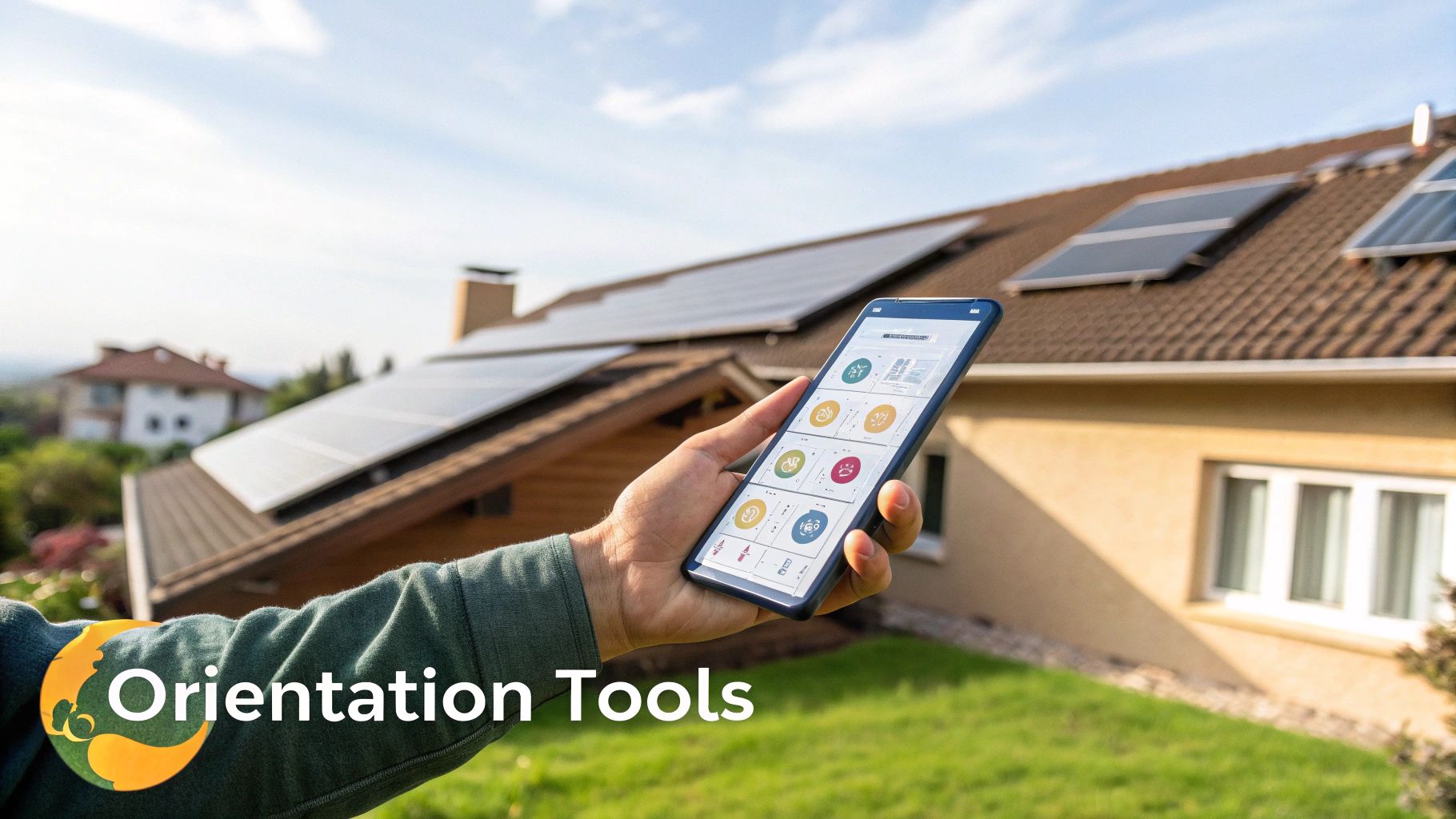
What If My Roof Doesn't Face South?
No south-facing roof? No problem. This is a very common situation, and you still have fantastic options for going solar. In fact, east- and west-facing roofs are often a great fit.
Think about it: a west-facing system is a powerhouse for capturing that late afternoon sun. This lines up perfectly with the time most families get home from work and school, when appliance use and energy demand are at their highest. An east-facing system, on the other hand, gets a jump-start on your day, covering your morning energy needs.
While the total yearly output might be 10-20% less than a "perfect" south-facing array, the electricity you generate might be more valuable because you're using it right when you need it most. Any good installer can run the numbers and show you exactly what to expect.
Should I Change My Panel Angle Every Season?
For nearly all residential rooftop systems, the answer is a simple no. Your panels are installed at a fixed angle—a sweet spot calculated to give you the best all-around production throughout the entire year for your specific location.
Trying to manually adjust the tilt of panels on your roof every few months is not only impractical but also a serious safety risk. Those adjustable mounts are really meant for ground-mounted systems where you can access them easily and safely.
While you could technically squeeze out an extra 5-10% in energy by tilting your panels seasonally, the added cost, complexity, and physical effort just don't make sense for the average homeowner. A well-planned fixed system is designed for set-it-and-forget-it performance.
How Much Power Will I Really Lose with a "Non-Ideal" Setup?
The energy loss from being slightly off the perfect orientation is probably less than you think. The drop-off is gradual, not a cliff.
For instance, being 20 degrees off true south might only trim your annual production by about 5-8%. Even panels facing directly east or west can still generate around 80-90% of the power of an optimally-aimed system.
What's the real performance killer? Shading. A little bit of shade from a tree branch or a chimney falling on just one part of your system can drag down the output of the whole array. Prioritizing a shade-free spot is often far more important than hitting that perfect compass heading.
Ready to see what a solar solution designed specifically for your home could look like? The expert team at Radiant Energy can create a custom system that maximizes your savings, no matter which way your roof faces. Get your free, no-obligation quote today!

